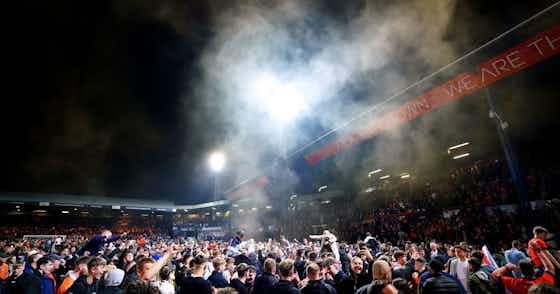Football365
·18 May 2023
Luton Town: The fall and rise of a football club eventually saved by love

In partnership with
Yahoo sportsFootball365
·18 May 2023

Luton Town are one game from the Premier League, but whatever happens in the Championship play-off final, they’ve come a long way just to get to this juncture.
“We’re one game away from the Premier League,” said Luton manager Rob Edwards after his team’s 2-0 win against Sunderland in their Championship play-off semi final. “That sounds surreal but we are. It’s a fact.” That’s one way of putting it, Rob. Last August, you were the manager of Luton’s bitterest rivals, plotting a quick return to the Premier League following their predictable relegation.

But it just so happened that these particular bitter rivals were Watford, so the managerial position there was on a strictly temporary basis, and when your temp contract came to an end at the end of September, you were at a bit of a loose end. But six weeks later, the Luton job became available after Nathan Jones was lured to Southampton. It was a bit of a gamble. Luton supporters might have been attaching pictures of your face to dartboards for aiming practice just a few weeks earlier, had you been successful at Vicarage Road. But you weren’t, and you absolutely have been since arriving at Luton. Welcome to Kenilworth Road, Agent Edwards.
To say that Luton Town have had a rollercoaster ride since they were last in the top flight of English football would be something of an understatement. They were relegated from the First Division at the end of the last season before the Premier League was introduced in 1992 – indeed they were one of the clubs that voted for its very existence – but by 2002 they were in the fourth tier after two further relegations.
Luton Town won promotion from the Third Division – now League Two – at the first attempt in 2002, but the club’s fortunes on the pitch were very different to what was going on away from it. They were losing money hand over fist, and in May 2003 they were sold by former owner Mike Watson-Challis to a consortium fronted by a businessman with a patchy past called John Gurney for £4.
Gurney was only in charge of the club for 55 days, but it’s fair to say that he got a lot done. He suggested that the club might change its name to London-Luton FC or perhaps merge with Wimbledon, and build a Formula One track around a 70,000-capacity stadium, which would have a removable pitch supported over the top of the nearby M1 motorway on concrete rafters.
Within three days he’d sacked popular manager Joe Kinnear and assistant Mick Harford and, after fan protest ended his hiring of Terry Fenwick, set up a poll which involved fans phoning premium rate telephone numbers to vote from a choice of managers. When 82% voted for Kinnear, he ignored the results and hired Mike Newell regardless. As if all of that wasn’t enough, the whole sordid charade was being recorded by a BBC television film crew for their series, ‘Trouble at the Top’.
Gurney only lasted 55 days. The Luton supporters mobilised, boycotting season tickets and instead raising money to buy another company owned by Watson-Challis, to whom the club owned a considerable amount of money. This allowed them to place Luton into adminstrative receivership and oust Gurney, whether he liked it or not. “If they expect me to walk away from Luton with nothing, I’ll make very sure there’s nothing to walk away from,” was Gurney’s comment as he was removed from the club. It turned out to very nearly be a rare example of him actually coming good on a promise.
Luton were promoted back to the Championship in 2005 for what turned out to be two years, but the club’s previous financial issues had never successfully been solved, and in November 2007 Luton Town collapsed into adminstration. There was a prospective purchaser, the LTFC2020 group, fronted by well-known supporter Nick Owen, but there were issues in getting HMRC to agree settlement, while on the pitch the ten-point deduction they incurred for entering into administration had dropped them to the bottom of League One.

Following relegation into League Two came two hammer blows in the space of a few weeks. First came another ten-point deduction over yet more shady behaviour by former directors and transfer irregularities, a ruling which particularly incensed supporters because it was punishing the club for the actions of people who had already left. And then they were deducted a further 20 points for their failure to exit administration with a CVA in place before the start of the 2008/09 season. This was an era of swingeing points deductions from the Football League, but Luton were hit worse than anyone else.
They were relegated from League Two at the end of that season. A 30-point deduction was too much to overcome, and an 89-year stay in the Football League came to an end. But they did at least leave with their heads held high. Despite their relegation, they took 40,000 supporters to Wembley for the final of the Football League Trophy, where they beat Scunthorpe United 3-2 after extra-time. The entire afternoon was a defiant middle finger raised in the direction of the Football League.
As an aside, at the time of this match Scunthorpe were headed for the Championship. They will be starting next season in the National League North.
It would take Luton five years to get back into the League, during which time they became the first non-league team to knock a top-flight side out of the FA Cup since 1989 when they beat Norwich City 1-0 at Carrow Road in 2013. The following season they were promoted back to the EFL with a club-record 101 points. And after finding their feet back in League Two, two successive promotions in 2018 and 2019 carried them all the way back to the Championship. Four years later, they are 90 minutes from finally getting to sample the Premier League that they voted for, all those years ago.
This turbulent history offers a little background as to why Luton are only now getting around replacing Kenilworth Road. For all its idiosyncracy, with its entrance into the away end built into a row of houses and one side that is just a row of executive boxes, with a capacity of 10,356 it’s too small for the modern era, especially if the club wants to solidify their place in the Championship, and especially especially if want to push for the Premier League. And redeveloping Kenilworth Road is simply out of the question. The ground is completely hemmed in by houses on three sides and the Luton Busway and main road on the other. The aerial view confirms just how little space there is to do anything with.
Over the years, there have been numerous attempts to move Luton into a new ground, of which John Gurney’s plans were not the most imaginative by as much of a distance as you might expect. One former owner, David Kohler, got as far as submitting plans in 1995 for what had become known as the ‘Kohlerdome’, a 20,000 all-seater indoor stadium with a retractable roof and pitch, which were rejected because it would have required widening the M1 motorway to make the project viable.
But this finally started to moved forward and planning permission was granted in 2019 for a new 17,500-capacity stadium, but work hasn’t started yet and it could be two or three years before it’s ready. In the meantime, chairman Gary Sweet has confirmed that it will cost the club £10m to bring Kenilworth Road up to scratch for the start of next season, should they be playing in the Premier League. That’s a relative drop in the ocean, considering that promotion would be worth a minimum of £200m to them through broadcasting revenue and, should it come to it, parachute payments, but even if the price is palatable, getting such work done before the start of next season would be a tall order.
And the atmosphere for the play-off match against Sunderland showed why, for all its flaws, Luton supporters do still love their ramshackle old home. The match was accompanied by an absolute wall of sound which grew to a crescendo as as Luton muscled their way past a first leg 2-1 deficit and on to Wembley. It’ll be their first appearance there since losing there in the Conference play-offs to York City in 2012, and it’s the second consecutive season that they’ve competed in the Championship play-offs.
Coventry City, another club to have been through the mill in recent years, stand in their way in the final following their 1-0 win at Middlesbrough in the other semi-final, but whatever happens in this match, that Luton Town should even be in this position in the first place is close to miraculous.
John Gurney’s 55 days in charge of the club could have killed them. The 30-point deduction issued by the Football League could have killed them. Three spells in administration in eight years could have killed them. But Luton Town were saved by love, because there were people who cared enough to the save them. And when we look at how so many football clubs have been treated over the years, including this one, it does starts to seem surreal.






























































